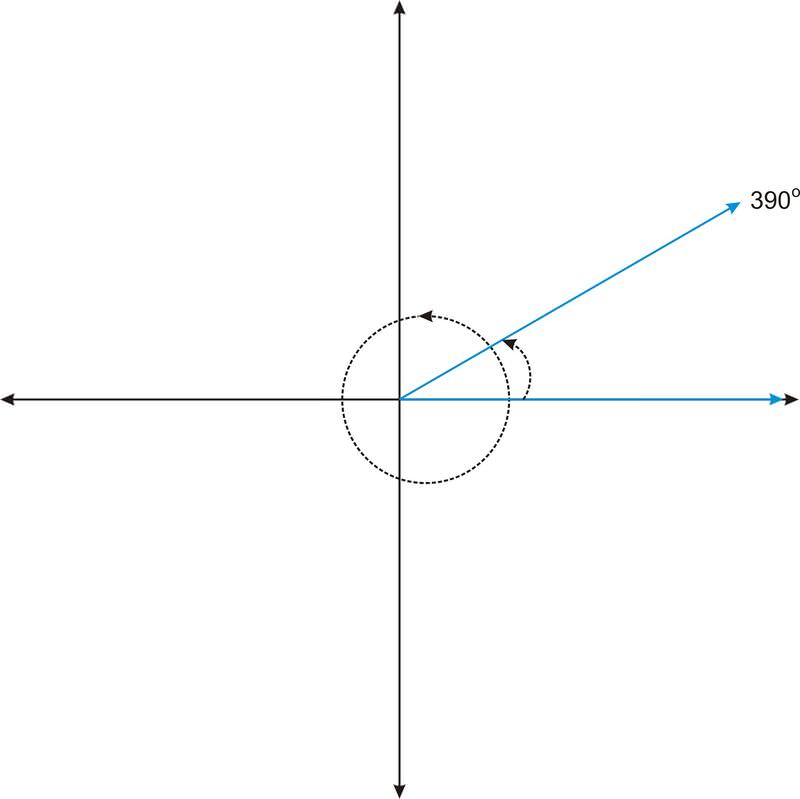2.3.4: Ángulos coterminales
- Page ID
- 107669
Conjunto de ángulos con el mismo terminal o lado final.
Mientras juegas un juego con amigos, usas un spinner que se ve así:

Como puedes ver, el ángulo que hace el spinner con la horizontal es\(60^{\circ}\). ¿Es posible representar el ángulo de otra manera?
Ángulos coterminales
Considera el ángulo\(30^{\circ}\), en posición estándar.

Ahora considera el ángulo\(390^{\circ}\). Podemos pensar en este ángulo como una rotación completa (\(360^{\circ}\)), más 30 grados adicionales.

Observe que\(390^{\circ}\) se ve igual que\(30^{\circ}\). Formalmente, decimos que los ángulos comparten el mismo lado terminal. Por lo tanto llamamos a los ángulos coterminales. No sólo estos dos ángulos son co-terminales, sino que hay infinitamente muchos ángulos que son co-terminales con estos dos ángulos. Por ejemplo, si giramos otro\(360^{\circ}\), obtenemos el ángulo\(750^{\circ}\). O bien, si creamos el ángulo en la dirección negativa (en sentido horario), obtenemos el ángulo\(−330^{\circ}\). Debido a que podemos rotar en cualquier dirección, y podemos rotar tantas veces como queramos, podemos generar continuamente ángulos que son co-terminales con\(30^{\circ}\).
Identificación de ángulos coterminales
Para las siguientes preguntas, determine si el ángulo es co-terminal con\(45^{\circ}\).
1. \(−45^{\circ}\)
No, no es co-terminal con\(45^{\circ}\)
2. \(405^{\circ}\)
Sí,\(405^{\circ}\) es co-terminal con\(45^{\circ}\).
3. \(−315^{\circ}\)
Sí,\(−315^{\circ}\) es co-terminal con\(45^{\circ}\).
Anteriormente, se le preguntó si es posible representar el ángulo de otra manera.
Solución
Puedes pensar en\(60^{\circ}\) como\(420^{\circ}\) si gieras todo el círculo una vez y continúas la rotación hasta donde se ha detenido el spinner, o como\(−300^{\circ}\) si giraras en el sentido de las agujas del reloj alrededor del círculo en lugar de en sentido antihorario hasta donde se ha detenido el spinner.
Encuentra un ángulo coterminal para\(23^{\circ}\)
Solución
Un ángulo coterminal sería un ángulo que se encuentra en el mismo lugar terminal que\(23^{\circ}\) pero que tiene un valor diferente. En este caso,\(−337^{\circ}\) es un ángulo coterminal.
Encuentra un ángulo coterminal para\(−90^{\circ}\)
Solución
Un ángulo coterminal sería un ángulo que está en el mismo lugar terminal que −90^ {\ circ}\) pero tiene un valor diferente. En este caso,\(270^{\circ}\) es un ángulo coterminal.
Encuentra dos ángulos coterminales a\(70^{\circ}\) girando en la dirección positiva alrededor del círculo.
Solución
Girar una vez alrededor del círculo da un ángulo coterminal de\(430^{\circ}\). Girar de nuevo alrededor del círculo da un ángulo coterminal de\(790^{\circ}\).
Revisar
- ¿Es\(315^{\circ}\) co-terminal con\(−45^{\circ}\)?
- ¿Es\(90^{\circ}\) co-terminal con\(−90^{\circ}\)?
- ¿Es\(350^{\circ}\) co-terminal con\(−370^{\circ}\)?
- ¿Es\(15^{\circ}\) co-terminal con\(1095^{\circ}\)?
- ¿Es\(85^{\circ}\) co-terminal con\(1880^{\circ}\)?
Para cada diagrama, nombra el ángulo de 3 maneras. Al menos una forma debe usar grados negativos.
-

Figura\(\PageIndex{4}\) -

Figura\(\PageIndex{5}\) -

Figura\(\PageIndex{6}\) -

Figura\(\PageIndex{7}\) -

Figura\(\PageIndex{8}\) - Nombra el ángulo del 8 en un reloj estándar de dos maneras diferentes.
- Nombra el ángulo del 11 en un reloj estándar de dos maneras diferentes.
- Nombra el ángulo del 4 en un reloj estándar de dos maneras diferentes.
- Explicar cómo determinar si dos ángulos son o no co-terminales.
- ¿Cuántas rotaciones hay\(4680^{\circ}\)?
Reseña (Respuestas)
Para ver las respuestas de Revisar, abra este archivo PDF y busque la sección 1.16.
vocabulario
| Término | Definición |
|---|---|
| Ángulos coterminales | Un conjunto de ángulos coterminales son ángulos con el mismo lado terminal pero expresados de manera diferente, como un número diferente de rotaciones completas alrededor del círculo unitario o ángulos que se expresan como mediciones de ángulo positivo versus negativo. |
Recursos adicionales
Video: Ejemplo: Determine si dos ángulos son coterminales
Práctica: Ángulos coterminales

